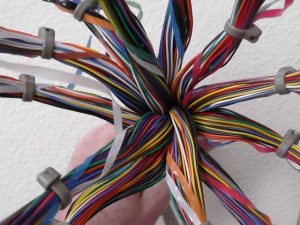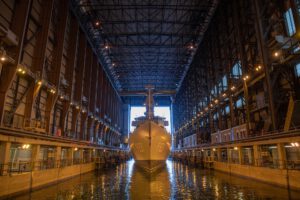Effective approach to the energy transition
In these 5 steps you can effectively tackle the energy transition as a municipality or province

The energy transition in a municipality or province involves a lot of work: from the sheer number of stakeholders to measures in a wide variety of areas. How do you ensure a complete picture and everyone is on the same page, ultimately resulting in an effective approach that everyone supports? Read on to find out.
1. Mapping the entire playing field and all stakeholders
First and foremost, it’s important to map the entire playing field, including all stakeholders. At Copernicos, we do this by focusing on systemic changes. What is needed to reduce pollution and emissions? To gain a complete picture, we map the following:
– All stakeholders, for example:
- Municipal and provincial officials
- Market players such as contractors and businesses
- Suppliers of (existing) equipment, such as polluting excavators and clean cars
- Residents
– Possible measures and everything surrounding them, such as:
- How do the possible measures work?
- When do you get which results?
- What are the costs?
- Are there unintended side effects? Consider, for example, certain polluting construction machinery that you no longer use. If there are no alternatives, construction will come to a standstill. This leads to less house construction and thus a housing problem. To prevent this, you take other measures.
– The knowledge needed to arrive at an effective approach
– The uncertainties and how to deal with them
To achieve this, we engage in discussions with all stakeholders and experts. We use the findings to create a shared narrative, forming a coherent set of cause-and-effect relationships. So, if you do this, that happens next. We demonstrate which points stakeholders agree on and which ones they disagree on. This way, you know exactly where the sticking points are and can discuss the various perspectives. This takes place in workshops, where you hear each other’s reasoning.
2. Comparing different measure packages with a simulation model
Once all the information is complete, the next step is to incorporate everything into a system dynamics model that you can use for simulation and calculation. This model visualizes all the reasoning lines and incorporates calculation formulas. This allows you to see exactly what effect all possible measures will have over time, not only on the objectives themselves, but also in terms of costs and disruption. For example:
- If you provide a sustainable subsidy, the model shows how it reduces CO2 emissions and how long it takes to achieve the target
- If you install particulate filters, the model indicates what they do with the emissions
- If you have pipes replaced, you have to open up streets. The model calculates the inconvenience for residents and the associated costs.
The model is ideal for comparing different packages of measures. This way, you can discover which combination yields the best results. Spoiler alert: you can never fully achieve all your goals. Therefore, it’s best to look for an optimal combination that takes various interests into account. After all, the more parties that support the measures, the greater the chance of success.
3. Further develop promising measures packages and preconditions
After the comparison, you’ll be left with a few promising packages of measures. We’ll further develop these into scenarios. A scenario consists of the following:
– An elaboration of the measures
– The preconditions for making the approach a success, such as:
- Required knowledge
- Financing
- Collaborations with new parties
– Uncertain factors and risks and how to deal with them
You want to avoid a lack of knowledge, funding, or resources to implement the energy transition measures. Therefore, the system dynamics model provides a detailed overview of the uncertainties and how to address them to achieve a successful outcome. Take, for example, large batteries for energy storage. The model provides insight into the knowledge gaps needed to implement these measures. Consider experiences from other municipalities or provinces and research into the potential of such batteries.
Furthermore, it’s crucial that the scenarios are realistic. If a fossil-fueled fleet or a series of central heating boilers hasn’t yet been depreciated, you’re not going to replace them. Moreover, it’s unsustainable to dispose of equipment that’s still functioning properly. So keep in mind that phasing these types of assets in and out takes time. If you don’t do this, there’s a good chance that stakeholders will become disappointed and have less confidence in the approach, which will lead to weaker support. So always ask yourself whether measures:
- Be socially feasible in terms of support
- Be technically feasible in terms of available technology and skilled workers
- Be economically feasible with the available budget
The model shows integrated results for all three of these feasibilities in conjunction, so that you can make a sound assessment.
4. Create and implement a concrete plan
The developed scenarios provide you with all the building blocks for creating a roadmap, or action plan, outlining what’s most effective and feasible. You’ll then detail the steps needed to achieve the sustainable goals. For example:
- How to acquire knowledge that is currently lacking
- When and how to implement the measures
- Who you work with to achieve a good result
- In what ways you meet all the preconditions
Once this is clearly on paper, you start working on the implementation.
5. Monitor and adjust
But it’s not wise to blindly execute your plan. Over time, you’ll gain more knowledge and understand the impact of certain decisions. Circumstances also change. Therefore, it’s a good idea to monitor implementation periodically. All interim results, new knowledge, and changing circumstances are fed into the model, allowing you to adjust and subsequently make better decisions.
Therefore, schedule a progress review session every quarter or at least every six months. By fine-tuning and optimizing, you’ll increasingly focus on your goals and ultimately achieve the best results quickly and efficiently.
Would you also like to get started with a practical model for the energy transition?
Are you enthusiastic about this step-by-step plan and want to approach the energy transition in your municipality or province this way? At Copernicos, we’re happy to help. We already have scenarios available for how construction equipment can make the energy transition, which are invaluable for every municipality and province. The same applies to energy price trends. We’re also happy to create a practical, robust model for any other topic related to the transition, helping you achieve a successful approach.
Want to know more or curious about what we can do for you? Contact us, and we’ll get back to you as soon as possible.
ALSO INTERESTING
other insights

The Transition Expedition
We are on our way to an uncertain future. A future we can discover together and that we want to make more sustainable than today. A future we can shape individually, but also collectively. To do so, we need to make choices.

Futurologist and Copernicos
In a presentation by futurologist Richard van Hooijdonck I heard a number of things that correspond with the Copernicos vision. Van Hooijdonck outlines a development that is currently underway: the world is in a process of connecting in which parts react, interact and influence each other.



